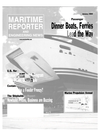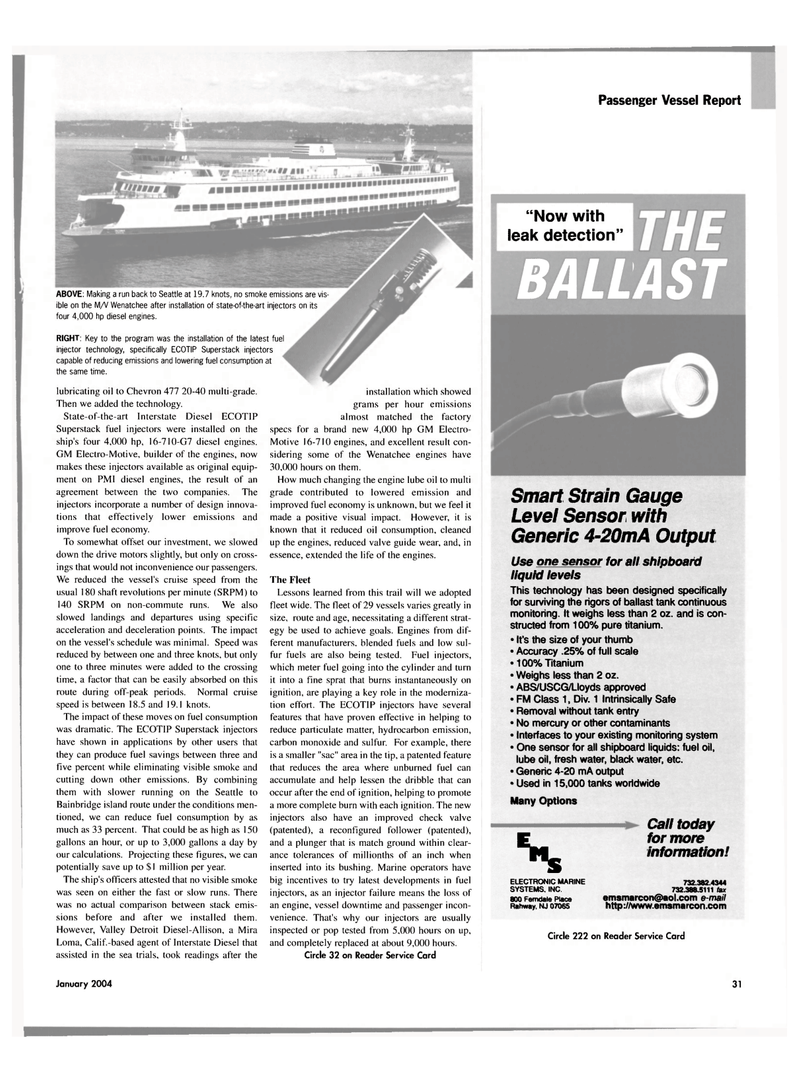
Page 31: of Maritime Reporter Magazine (January 2004)
Ferry & Passenger Vessel Yearbook
Read this page in Pdf, Flash or Html5 edition of January 2004 Maritime Reporter Magazine
ABOVE: Making a run back to Seattle at 19.7 knots, no smoke emissions are vis- ible on the M/V Wenatchee after installation of state-of-the-art injectors on its four 4,000 hp diesel engines.
RIGHT: Key to the program was the installation of the latest fuel injector technology, specifically ECOTIP Superstack injectors capable of reducing emissions and lowering fuel consumption at the same time. lubricating oil to Chevron 477 20-40 multi-grade.
Then we added the technology.
State-of-the-art Interstate Diesel ECOTIP
Superstack fuel injectors were installed on the ship's four 4,000 hp, 16-710-G7 diesel engines.
GM Electro-Motive, builder of the engines, now makes these injectors available as original equip- ment on PMI diesel engines, the result of an agreement between the two companies. The injectors incorporate a number of design innova- tions that effectively lower emissions and improve fuel economy.
To somewhat offset our investment, we slowed down the drive motors slightly, but only on cross- ings that would not inconvenience our passengers.
We reduced the vessel's cruise speed from the usual 180 shaft revolutions per minute (SRPM) to 140 SRPM on non-commute runs. We also slowed landings and departures using specific acceleration and deceleration points. The impact on the vessel's schedule was minimal. Speed was reduced by between one and three knots, but only one to three minutes were added to the crossing time, a factor that can be easily absorbed on this route during off-peak periods. Normal cruise speed is between I 8.5 and 19.1 knots.
The impact of these moves on fuel consumption was dramatic. The ECOTIP Superstack injectors have shown in applications by other users that they can produce fuel savings between three and five percent while eliminating visible smoke and cutting down other emissions. By combining them with slower running on the Seattle to
Bainbridge island route under the conditions men- tioned, we can reduce fuel consumption by as much as 33 percent. That could be as high as 150 gallons an hour, or up to 3,000 gallons a day by our calculations. Projecting these figures, we can potentially save up to $1 million per year.
The ship's officers attested that no visible smoke was seen on either the fast or slow runs. There was no actual comparison between stack emis- sions before and after we installed them.
However, Valley Detroit Diesel-Allison, a Mira
Loma, Calif.-based agent of Interstate Diesel that assisted in the sea trials, took readings after the installation which showed grams per hour emissions almost matched the factory specs for a brand new 4,000 hp GM Electro-
Motive 16-710 engines, and excellent result con- sidering some of the Wenatchee engines have 30,000 hours on them.
How much changing the engine lube oil to multi grade contributed to lowered emission and improved fuel economy is unknown, but we feel it made a positive visual impact. However, it is known that it reduced oil consumption, cleaned up the engines, reduced valve guide wear, and, in essence, extended the life of the engines.
The Fleet
Lessons learned from this trail will we adopted fleet wide. The fleet of 29 vessels varies greatly in size, route and age, necessitating a different strat- egy be used to achieve goals. Engines from dif- ferent manufacturers, blended fuels and low sul- fur fuels are also being tested. Fuel injectors, which meter fuel going into the cylinder and turn it into a fine sprat that burns instantaneously on ignition, are playing a key role in the moderniza- tion effort. The ECOTIP injectors have several features that have proven effective in helping to reduce particulate matter, hydrocarbon emission, carbon monoxide and sulfur. For example, there is a smaller "sac" area in the tip, a patented feature that reduces the area where unburned fuel can accumulate and help lessen the dribble that can occur after the end of ignition, helping to promote a more complete burn with each ignition. The new injectors also have an improved check valve (patented), a reconfigured follower (patented), and a plunger that is match ground within clear- ance tolerances of millionths of an inch when inserted into its bushing. Marine operators have big incentives to try latest developments in fuel injectors, as an injector failure means the loss of an engine, vessel downtime and passenger incon- venience. That's why our injectors are usually inspected or pop tested from 5,000 hours on up, and completely replaced at about 9,000 hours.
Circle 32 on Reader Service Card
Passenger Vessel Report
BALLAST "NOW with leak detection"
Smart Strain Gauge
Level Sensor with
Generic 4-20mA Output
Use one sensor for all shipboard liquid levels
This technology has been designed specifically for surviving the rigors of ballast tank continuous monitoring. It weighs less than 2 oz. and is con- structed from 100% pure titanium. • It's the size of your thumb • Accuracy .25% of full scale • 100% Titanium • Weighs less than 2 oz. • ABS/USCG/Lloyds approved • FM Class 1, Div. 1 Intrinsically Safe • Removal without tank entry • No mercury or other contaminants • Interfaces to your existing monitoring system • One sensor for all shipboard liquids: fuel oil, lube oil, fresh water, black water, etc. • Generic 4-20 mA output • Used in 15,000 tanks worldwide
Many Options
S
ELECTRONIC MARINE
SYSTEMS, INC. 800 Ferndale Place
Rahway, NJ 07065
Call today for more information! 732.382.4344 732.388.5111 fax [email protected] e-mail http ://www.emsmarcon.com
Circle 222 on Reader Service Card
January 2004 31

 30
30

 32
32
